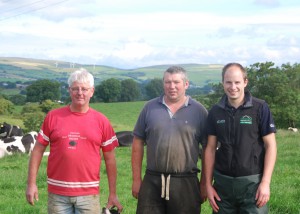
Following one of the six strategies from the National Johne’s Management Plan is helping to deliver control of this challenging disease to farmers across the country.
Strategy 3: Improved farm management, risk assessment and strategic testing
Stuart Webster and his herdsman John Hind farm 170 pedigree Holsteins and followers at Aurora Park Farm, Scales located just a mile from the coastline of the Furness Peninsula in Cumbria. The 250 acres is mainly grass, with just five acres put down to whole crop each year, needless to say cows are grazed through summer and then cubicle housed through winter on a diet of grass silage, whole crop and moist feeds.
First cut silage is taken on the 11th May (weather permitting), with second cut five weeks later and a third and final cut taken end of July/early August. Silage is analysed each year and the concentrates fed in the parlour adjusted accordingly. The cows currently receive a 16% protein cake fed to yield to a maximum of 8kg. On this relatively conventional system the cows are performing well averaging 9600kg at 3.8% fat and 3.12% protein, with SCC of 93 x1000cells/ml based on their 12 month rolling average.
Operating a completely closed herd, Stuart and John are focussed on maintaining a high herd health status and as part of this have been monitoring the milking herd for Johne’s disease for five years.
Stuart explains that when they started recording with the CIS, they began milk testing each cow for Johne’s disease as well, adopting Strategy 3 from the NJMP of ‘Improved Farm management and Strategic Testing’. Thankfully test results have always shown a low incidence of the disease and interestingly the only cows that classified red/amber were almost always ones that were on the list to cull anyway.
Since starting the monitoring process, the milking herd are tested every quarter and reviewed with vet Andrew Crutchley at the routine visit. A blood or faecal sample is also collected from any suspicious cows. Any cows showing red from a milk test result and a positive result from a blood sample are considered high risk. If in-calf, they are calved separately and kept well away from the calving pen and young stock until they are culled. John adds they don’t keep any calves from suspect positive cows and are also very careful to ensure no colostrum is taken from them.
Both the regular monitoring and careful management of high risk animals has seen a continual decline in the number of cows falling into red or amber categories on the milk test results and on the latest test the entire milking herd was green. This won’t stop Stuart and John continuing to monitor though as Stuart explains, the testing provides ongoing reassurance and as a closed herd breeding all their own replacements it is important to guarantee the next generation of heifers have no underlying health issues.
Implementing a control programme has being particularly important at Aurora Park as calves are fed, in the first instance, their dam’s colostrum and then reared to weaning on whole milk from the herd. It is therefore essential that the calves are only receiving milk from cows shown not to be shedding Johne’s disease minimising the risk of any possible transmission into the young stock.
The Johne’s disease monitoring scheme is just one part of the infectious disease control plan for Aurora Park Farm, with the herd currently BVD free, Leptospriosis vaccinated and IBR monitored. As the herd is pedigree, maintaining this known health status certainly adds value to any surplus heifers that Stuart sells, he adds that looking to the future they may go a step further and aim to achieve fully accredited Johne’s disease free status.
The fertility figures for the herd also demonstrates how well managed and healthy the cows are. The current calving interval is running at 384 days, average days to first service 55 and average days to conception is just 87. On average 2.2 straws are used per cow, with AI commencing from 40 days and 43% of all services resulting in conception. Any cows not served by 42 days are presented at the next routine vet visit for treatment. If treatment is unsuccessful they are programmed for fixed time AI (Ovsynch). Aiding them in keeping the calving interval down is the Silent Herdsman System and they use a mating programme from Semex to minimise any inbreeding. Sexed semen is used on heifers, with a Hereford bull used to sweep up and an aim to calve them in at two years old. The majority of the rest of the herd are bred pure with a small amount of British Blue and Fertility Plus semen used to sweep up and for the lower end of the herd.
Operating a replacement rate of around 25%, the current herd dynamic is a varied mix of ages from the 41 heifers milking ranging through to some 10th calved cows. With improved herd health over the years and the use of sexed semen in the heifers providing more available replacements, Stuart and John have seen a noticeable and welcome shift towards more voluntary culls, with three key areas looked at, lameness, fertility and cell counts. Being in the position to make voluntary culls has also attributed to improvements in the herds performance.
Looking to the future there are plans to make some modifications to the farm, in particular improving the cubicle housing and moving from paper waste and straw to rubber mats to reduce hock swellings and improve cow comfort. The parlour is also targeted for a remodel scaling up from the 12×24 herringbone to a 20×24 reducing milking time, although there are no plans to increase herd size as land is the limiting factor. Herd health will remain a priority for Stuart and John and alongside their careful management and guidance from Andrew at Westmorland Veterinary Group the Aurora herd will continue to perform.
